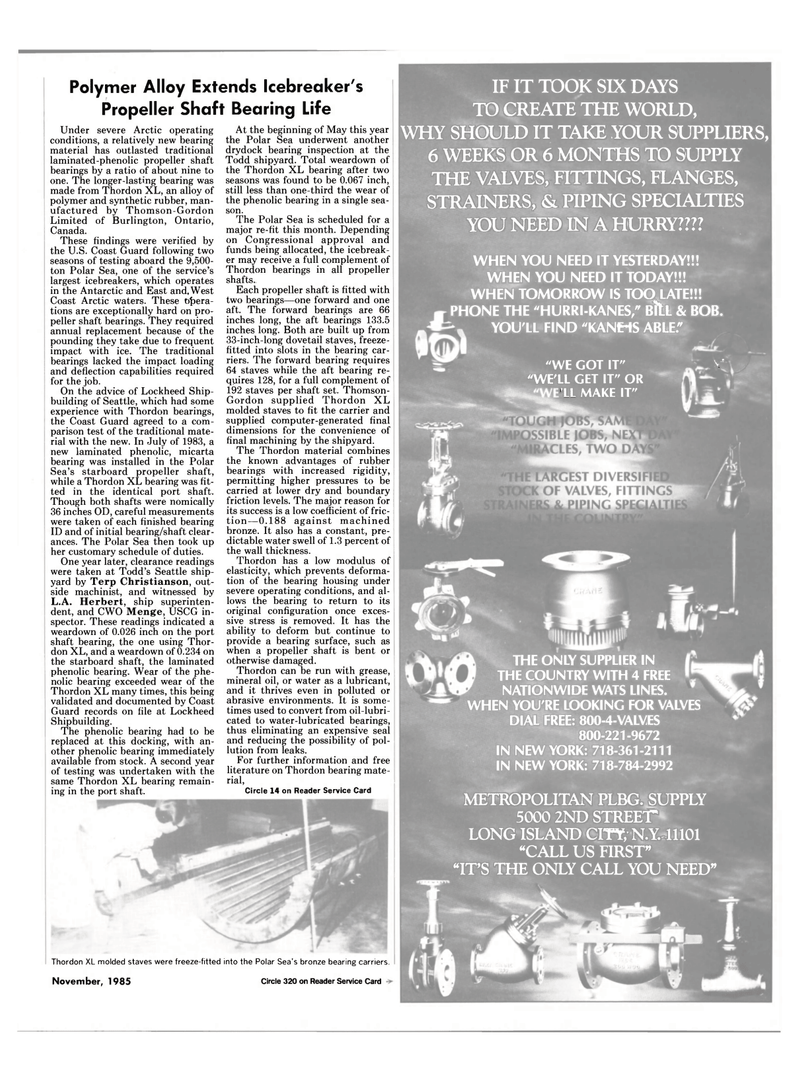
Page 115: of Maritime Reporter Magazine (November 1985)
Read this page in Pdf, Flash or Html5 edition of November 1985 Maritime Reporter Magazine
IF IT TOOK SIX DAYS
TO CREATE THE WORLD,
WHY SHOULD IT TAKE YOUR SUPPLIERS, 6 WEEKS OR 6 MONTHS TO SUPPLY
THE VALVES, FITTINGS, FLANGES,
STRAINERS, & PIPING SPECIALTIES
YOU NEED IN A HURRY????
WHEN YOU NEED IT YESTERDAY!!!
WHEN YOU NEED IT TODAY!!!
WHEN TOMORROW IS TOO LATE!!!
PHONE THE "HURRI-KANES," Bill & BOB.
YOU'LL FIND "KANWS ABLE." "WE GOT IT" "WE'LL GET IT" OR 'LL MAKE IT"
V
THE ONLY SUPPLIER IN
THE COUNTRY WITH 4 FREE
NATIONWIDE WATS LINES.
WHEN YOU'RE LOOKING FOR VALVES
DIAL FREE: 800-4-VALVES 800-221-9672
IN NEW YORK: 718-361-2111
IN NEW YORK: 718-784-2992
METROPOLITAN PLBG. SUPPLY 5000 2ND STREET
LONG ISLAND CITY, N.Y. 11101 "CALL US FIRST" "ITS THE ONLY CALL YOU NEED"
Polymer Alloy Extends Icebreaker's
Propeller Shaft Bearing Life
Under severe Arctic operating conditions, a relatively new bearing material has outlasted traditional laminated-phenolic propeller shaft bearings by a ratio of about nine to one. The longer-lasting bearing was made from Thordon XL, an alloy of polymer and synthetic rubber, man- ufactured by Thomson-Gordon
Limited of Burlington, Ontario,
Canada.
These findings were verified by the U.S. Coast Guard following two seasons of testing aboard the 9,500- ton Polar Sea, one of the service's largest icebreakers, which operates in the Antarctic and East and. West
Coast Arctic waters. These Opera- tions are exceptionally hard on pro- peller shaft bearings. They required annual replacement because of the pounding they take due to frequent impact with ice. The traditional bearings lacked the impact loading and deflection capabilities required for the job.
On the advice of Lockheed Ship- building of Seattle, which had some experience with Thordon bearings, the Coast Guard agreed to a com- parison test of the traditional mate- rial with the new. In July of 1983, a new laminated phenolic, micarta bearing was installed in the Polar
Sea's starboard propeller shaft, while a Thordon XL bearing was fit- ted in the identical port shaft.
Though both shafts were nomically 36 inches OD, careful measurements were taken of each finished bearing
ID and of initial bearing/shaft clear- ances. The Polar Sea then took up her customary schedule of duties.
One year later, clearance readings were taken at Todd's Seattle ship- yard by Terp Christianson, out- side machinist, and witnessed by
L.A. Herbert, ship superinten- dent, and CWO Menge, USCG in- spector. These readings indicated a weardown of 0.026 inch on the port shaft bearing, the one using Thor- don XL, and a weardown of 0.234 on the starboard shaft, the laminated phenolic bearing. Wear of the phe- nolic bearing exceeded wear of the
Thordon XL many times, this being validated and documented by Coast
Guard records on file at Lockheed
Shipbuilding.
The phenolic bearing had to be replaced at this docking, with an- other phenolic bearing immediately available from stock. A second year of testing was undertaken with the same Thordon XL bearing remain- ing in the port shaft.
At the beginning of May this year the Polar Sea underwent another drydock bearing inspection at the
Todd shipyard. Total weardown of the Thordon XL bearing after two seasons was found to be 0.067 inch, still less than one-third the wear of the phenolic bearing in a single sea- son.
The Polar Sea is scheduled for a major re-fit this month. Depending on Congressional approval and funds being allocated, the icebreak- er may receive a full complement of
Thordon bearings in all propeller shafts.:
Each propeller shaft is fitted with two bearings—one forward and one aft. The forward bearings are 66 inches long, the aft bearings 133.5 inches long. Both are built up from 33-inch-long dovetail staves, freeze- fitted into slots in the bearing car- riers. The forward bearing requires 64 staves while the aft bearing re- quires 128, for a full complement of 192 staves per shaft set. Thomson-
Gordon supplied Thordon XL molded staves to fit the carrier and supplied computer-generated final dimensions for the convenience of final machining by the shipyard.
The Thordon material combines the known advantages of rubber bearings with increased rigidity, permitting higher pressures to be carried at lower dry and boundary friction levels. The major reason for its success is a low coefficient of fric- tion—0.188 against machined bronze. It also has a constant, pre- dictable water swell of 1.3 percent of the wall thickness.
Thordon has a low modulus of elasticity, which prevents deforma- tion of the bearing housing under severe operating conditions, and al- lows the bearing to return to its original configuration once exces- sive stress is removed. It has the ability to deform but continue to provide a bearing surface, such as when a propeller shaft is bent or otherwise damaged.
Thordon can be run with grease, mineral oil, or water as a lubricant, and it thrives even in polluted or abrasive environments. It is some- times used to convert from oil-lubri- cated to water-lubricated bearings, thus eliminating an expensive seal and reducing the possibility of pol- lution from leaks.
For further information and free literature on Thordon bearing mate- rial,
Circle 14 on Reader Service Card
Thordon XL molded staves were freeze-fitted into the Polar Sea's bronze bearing carriers.
November, 1985 Circle 320 on Reader Service Card

 114
114

 116
116
